
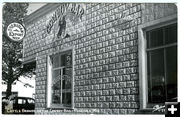
Cowboy Bar Postcard
Sanborn postcard of the Cowboy Bar from the height of the brands era. Photo courtesy Carmen Hittle.
|

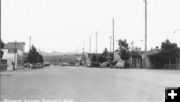
Pinedale 1945
Sanborn Postcard from 1945 that appears to show the Cowboy Bar while the brands are being painted. See next picture for close up of the bar. Photo courtesy Sublette County Historical Society.
|

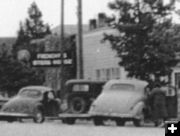
Cowboy Bar 1945
Closer view of Cowboy Bar from 1945. The white pressed tin siding is visible. However, there appears to be scaffolding and tarps over the area where the brands were painted just behind the Frenchy's Steak House sign. The picture was possibly taken while the brands were being painted. Photo courtesy Sublette County Historical Society.
|

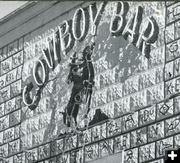
Neon Sign
Postcard Detail: This sign was above a window on the north side of the building, facing Pine Street. That window was turned into a door, which is the present main entry into the Bar.
|


Bar Window detail
Postcard Detail: Liquor Store -
No Permit Required.
Note the reflection of the word "BAR" in the window. It appears this sign was attached to a light or telehone pole out on the street.
|

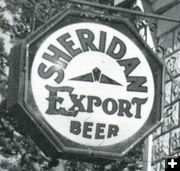
Sheridan Export Beer
Postcard Detail: The Sheridan Brewing Company, in Sheridan, Wyoming, operated from 1885 until 1954.
|

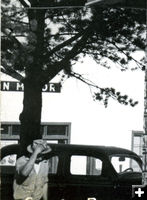
Bar Entry
Postcard Detail: Note the mature evergreen tree to the left, near the entry door. A fire hydrant is there now. The building across the street was a car repair shop and dealership. Ann Noble's Pinedale Centennial History book is a great resource for photos of early Pinedale (see sources at the end of this article)
|
|
Early History of the Cowboy Bar and Its Brands
Outlaws, prohibition, murder, robberies and cattlemen
by Clint Gilchrist & Dawn Ballou, Pinedale Online!
July 1, 2011
It has been exciting to find the brands on the Cowboy Bar that have been covered for 59 years. The story behind the brands goes much deeper into our Pinedale heritage. It’s almost the ingredients for an old west movie script - but in the case of the Cowboy Bar, these stories are all true.
While research on the brands continues, the early history of the bar is emerging. Here is what we know so far.
Walt Punteney
The Cowboy Bar was built in 1931 by Walt Punteney in the later years of his life. He was born in 1870 in Kansas, moved to Pinedale in 1926, and passed away in 1950. In between was an adventurous life. His obituary states that at age 18 he came to Thermopolis, Wyoming and quickly became known throughout the state for his ability to break horses. He worked on, and operated, several ranches around the state. By 1893, he was appearing as a top rider and roper in Buffalo Bill’s Wild West Show.
However, his obituary leaves out one interesting story. Walt rode with Butch Cassidy’s Wild Bunch. He was arrested for participating in the Butte County bank robbery in Belle Fourche, South Dakota in 1897. The true story is sketchy, with historians writing several different accounts. What is known is that six men robbed the bank on June 28th. Tom O’Day was captured in town when his horse ran away. In September, Walt Punteney and two other men were captured in Montana and taken to Belle Fourche to be put on trial for the robbery. A bank teller identified the men as taking part in the robbery. The identity of the two men with Punteney is unknown, but it is suspected they were Harry Longabaugh (Sundance Kid) and Harvey Logan (Kid Curry). All four men escaped in October, but O’Day and Punteney were soon recaptured and put on trial. With the help of prominent legal counsel, the charges against Punteney were dropped and O’Day was acquitted. Speculation is that Butch Cassidy paid for the high-priced lawyers. There is no evidence Walt participated in any other Wild Bunch robberies, but he did live in the "Hole-In-The-Wall" area for many years.
Walt’s last name is often misspelled as Putney or Puteney, but the spelling on his grave stone is Punteney. He is buried in the Pinedale, Wyoming cemetery.
Rendezvous Pool Hall
The Punteney Building was built on the corner of Maybell and Pine in Pinedale in April and May of 1931. By June 1931, the Rendezvous Pool Hall and Rendezvous Restaurant were open for business. The building appears to have been built on a vacant spot, but this location may have been where Bates Photography was previously located in the first years of the town. The Punteney Building is incorporated in the larger building that still stands there today. Two small log cabins previously owned by the Bloom family, dating back as far as 1920, were located on what is now the parking lot behind the bar. Many decades later, then-owner Courtney Davis traded the two cabins to Phelps and Sally Swift in exchange for building the parking lot. The cabins were restored and are still located on the Swift Ranch near Boulder, approximately eleven miles south of Pinedale.
Prohibition
Walt built his Pool Hall and Restaurant less than two years into the Great Depression and eleven years into Prohibition. With ratification of the 18th Amendment to the U. S. Constitution and passage of the Volstead Act, prohibition of "intoxicating liquor" went into effect in January, 1920. "Intoxicating liquor" was defined as any beverage containing more than 0.5% alcohol. From 1912, when Pinedale was incorporated, until 1919, liquor licenses usually accounted for more than 80% of Town income. Because of Prohibition, the Town shifted to a property tax to pay its bills. The last liquor licenses were issued to Art Doyle’s Fremont Saloon, and Gus Fardy’s Pines Bar where Stockman’s is now.
Pool halls offered a gathering spot and advertised candy, soft drinks, cigars, nuts, and tobacco - but some provided intoxicating liquors in the back. A raid in 1929 (two years prior to when the Cowboy Bar building was built) found liquor in two Pinedale pool halls. The liquor was destroyed and owners fined.
Prohibition became increasingly unpopular during the Great Depression. An amendment was passed in March, 1933 which redefined intoxicating liquor. The Pinedale Town Council wasted no time passing an ordinance and issuing "non-intoxicating malt liquor licenses" to Ida Fardy, Francis Hazen, Walt Punteney, John Graham, and J. F. McCormick. Non-intoxicating liquor was basically beer with less than 4% alcohol content.
Prohibition was finally repealed in December of 1933. State and Town enabling laws were passed by March 1935 and Pinedale was allowed to issue two retail liquor licenses which they gave to Walt Punteney and J.F. McCormick on a secret ballot out of five applicants. McCormick operated what is now the Corral Bar. In 1937, the Town was issued another license that was given to Charles Wood who operated what is now Stockman’s Bar.
Walt Punteney operated his bar until 1944 under several different names including Rendezvous Pool Hall and Bar-B-Q, Rendezvous Liquor, and Rendezvous Bar.
Casey’s Cowboy Bar and the Brands
In 1944, Walt leased and later sold the bar to a newcomer, Casey Hensley, who renamed it the Cowboy and Stockman’s Bar. It appears the Stockman’s part was dropped fairly quickly and the bar was known as Casey’s Cowboy Bar. Casey was 44-years old, a WWI vet, originally from Kansas, but most recently from Thermopolis where many of his family lived, as did Walt’s brother.
During the winter of 1944-45, Casey placed a "Stockmen Notice" in the Pinedale Roundup newspaper stating, "We are compiling a list of all brands in Sublette County, together with history attached. These brands will be as decorative material both inside and outside Casey’s Cowboy Bar". Most of the brands were probably painted on the new siding in the summer of 1945. A Sanborn photo from 1945 appears to show covered scaffolding over the side of the Cowboy Bar where the brands are being painted. This photo can be seen on page 151 of the Pinedale centennial history book published by the Sublette County Historical Society, authored by Pinedale historian Ann Noble. Later Sanborn photos owned by Carmen Hittle and Tony Keys show a close-up look at the brand siding in its prime.
Casey gave the bar its name and now distinctive look, but his ownership was short lived. A 3:15 in the morning on a Sunday morning July 7, 1946, Casey was shot and killed. Two thieves had earlier stolen a slot machine from the Fremont Café. Casey, still working late at the Cowboy Bar, was one of the townspeople who responded to help find the thieves. Casey eventually apprehended one of the criminals, but was shot in the scuffle in an alley and passed away shortly after. The robbers were captured and eventually pled Guilty to manslaughter. Each served less than two years in the Wyoming State Penitentiary before being paroled.
Jack Mudd
With the death of Casey Hensley, the estate holding "Casey’s Cowboy Bar" sold the establishment to John "Jack" Mudd. Mudd from the Rock Springs area was 35-years old, but had been in Pinedale for a long time. As early as 1931, he ran an excursion boat on Fremont Lake. During the 30’s he had a automobile repair shop and was the area salesman for Dodge and Chevy. From 1939-1943, he served as the Mayor of Pinedale until he was called to duty as a Lieutenant in the Navy. During service, he was a flight instructor, test pilot, and personnel transport pilot. Jack returned from the war in 1946 and by the summer of 1947 owned the now name-shortened Cowboy Bar, by which it has been known ever since. Jack operated the bar until 1951, when he passed away from a heart attack at 40-years old.
Covering the Brands
Colorful local legend says Henry Hittle won the Cowboy Bar in a card game. While there may be some truth to the story, an article in the November 11, 1951 Pinedale Roundup tells the less exciting side. The article states that Henry Hittle purchased the Cowboy Bar and Chuck Room Restaurant from the Jack Mudd estate and Mary Mudd, Jack’s widow. Henry was a stockman from Eastfork and retained George Hartley to manage the bar.
A February, 1952 Pinedale Roundup article, "Cowboy Bar, Chuck Room Getting Face Lifting," appears to signal the end of the brand siding era of the Cowboy Bar after a little less than seven years. The article states that "attractive log siding is being applied to the north and east sides of the building." We can only speculate why Henry decided to cover the brands, but research into pressed tin siding of the era indicates that it was fairly maintenance intensive, having to be painted often. That could have been difficult with the brands. Henry Hittle gave us a great gift of our heritage 59 years later by leaving the now-historic siding on the bar and covering it up, rather than removing it when he resided the building.
There is a rich history of Henry’s ownership, as well as the Newcomb boys, Fred Lindbeck, and finally Courtney Davis who owned the bar for almost 40 years and started the "Pinedale Thinking Service" and "Happy Taxpayer’s Club" - but those are stories for another day.
There is also a deep history of the brands on the bar. We are researching that now and will also leave those stories for another day. We welcome any information on the history of the bar or specific brands. For more information, contact Clint Gilchrist, clint@sublette.com, 307-367-6763.
Thanks to Courtney Davis, Carmen Hittle and Jonita Sommers for help with research.
Sources
Pinedale Roundup (DVDs available at both Sublette County libraries; Online viewable pages at NewspaperArchive.com for a fee.)
"Pinedale, Wyoming: A Centennial History 1904-2004" by Ann Chambers Noble/Sublette County Historical Society
Town of Pinedale Meeting Minutes (Town of Pinedale)
"Butch Cassidy" by Richard Patterson
|






